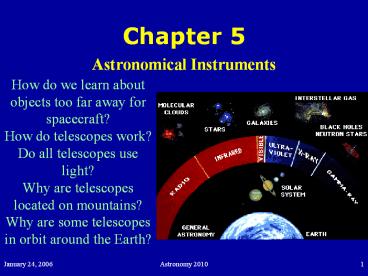Astronomical Instruments - PowerPoint PPT Presentation
Title:
Astronomical Instruments
Description:
Title: Chapter 1 Author: Robert Harr Last modified by: Robert Harr Created Date: 9/8/2003 10:52:05 PM Document presentation format: On-screen Show Company – PowerPoint PPT presentation
Number of Views:2885
Avg rating:3.0/5.0
Title: Astronomical Instruments
1
Chapter 5
- Astronomical Instruments
How do we learn about objects too far away for
spacecraft? How do telescopes work? Do all
telescopes use light? Why are telescopes located
on mountains? Why are some telescopes in orbit
around the Earth?
2
5.1 Telescopes
- Telescopes are devices for seeing distant
objects. - To see faint objects, collect more light by using
a bigger aperture. - Magnification is much, much less important.
- Two types of optical telescopes
- Refracting
- Reflecting
3
Refracting Telescopes
- Use a large lens as the primary light collecting
element. - Common in older telescopes.
- Chromatic aberrations and ultraviolet cutoff.
4
(No Transcript)
5
Reflecting Telescopes
- Use a large mirror as the primary light
collecting element. - Easier to make a large mirror than a large lens.
- Modern telescopes are reflectors.
- Reduced chromaticity problems.
6
Refracting versus Reflecting
7
Prime, Newton, and Cassegrain
8
5.2 Optical Detectors and Instruments
- Second greatest advance in astronomy was the use
of photographic film - Longer integration time than the eye.
- Images available for later (re)inspection.
- The 3 uses of telescopes
- Imaging
- Measuring brightness and color
- Spectroscopy
- All benefit from longer integration time.
9
Charge-Coupled Device
- A modern advance is the use of charge-coupled
devices or CCDs. - These are the digital film of digital cameras.
10
5.3 Optical and Infrared Observatories
- Ground based telescopes are housed in domes or
other structures to protect them when not in use. - They are often located on remote mountains, away
from lights, and smog, and above humid and
turbulent air.
11
NOAO on Kitt Peak, AZ
12
South African Large Telescope
13
European Southern Observatory
14
Choice of Telescope Sites
- Weather clouds, wind, and rain limit observing
time. - Water vapor water vapor in the atmosphere
filters out infrared wavelengths. - Darkness city light can overwhelm faint stars.
- Turbulence turbulent air blurs images.
15
Observatory Sites
- Newest telescopes are sited in the Chilean Andes,
desert peaks of Arizona, Canary Islands, and
Mauna Kea in Hawaii. - Modern telescopes can use segmented mirrors,
adaptive optics, and interferometry.
16
Observing Other Radiation
- To learn the most about planets, stars, and
galaxies, astronomers use as many types of
radiations as possible. - Radio
- Infrared and ultraviolet
- X-rays
- Gamma rays
17
5.4 Radio Telescopes
- Many objects emit radio waves, from long wave to
microwaves. - Radio telescopes generally look like large
satellite dishes. - They can operate during the day and night.
- Large facilities in Puerto Rico, West Virginia,
and New Mexico.
18
(No Transcript)
19
The Very Large Array (VLA)
20
The VLBA Spans A Continent
21
Radio Image of Quasar Jets
22
5.5 Observatories Outside the Earths Atmosphere
- Some wavelengths of radiation are absorbed by
Earths atmosphere (gamma rays, x-rays, and
ultraviolet). - Telescopes for these wavelengths must be put in
space. - The Hubble telescope demonstrates the advantages
for an optical telescope to be above the
atmosphere.
23
The Hubble Space Telescope
24
The Swift Satellite (GRBs)































